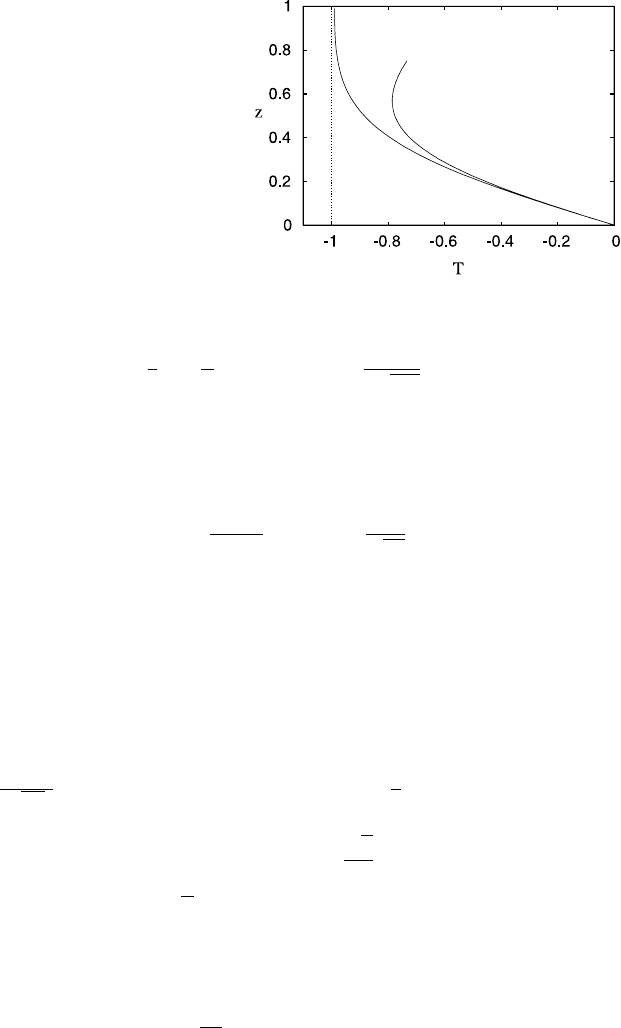Fowler A. Mathematical Geoscience
Подождите немного. Документ загружается.


640 10 Glaciers and Ice Sheets
Away from the base, the temperature satisfies (10.68). More specifically (see
Question 10.5), we can write the outer solution in the form
T =f
z
s
s
0
s
a
J
ds
, (10.79)
where the integral is along a flow line χ = constant, and J is the Jacobian
J =−
∂(s,χ)
∂(x,y)
> 0 (10.80)
of the transformation from (x, y) to (−s,χ).Heres
0
is the surface elevation at the
ridge forming the ice divide where the flow line starts.
Insofar as we might suppose the surface temperature decreases with increasing
elevation, it is reasonable to suppose that f is an increasing function of its argument,
and thus the temperature in (10.79) increases with height. As z → 0, T →f(0)<0,
and there is a temperature inversion in a thermal boundary layer through which
T →0. In this layer, the plug flow velocity is unaffected, as the exponential terms
are negligible. We write
z =β
1/2
Z, (10.81)
so that the temperature equation takes the approximate form
uT
x
+vT
y
−ZT
Z
=T
ZZ
. (10.82)
It is convenient again to write this in terms of the coordinates s, χ , Z, when the
equation becomes
−J [UT
s
−ZU
s
T
Z
]=T
ZZ
, (10.83)
with boundary conditions
T =0onZ =0,
T →f(0) as Z →∞.
(10.84)
We can simplify this by defining
X =
s
0
s
ds
J
,Ψ=ZU, (10.85)
which reduces the problem to
Ψ
Z
T
X
−Ψ
X
T
Z
=T
ZZ
. (10.86)
A further Von Mises transformation to independent variables (X, Ψ ) reduces this to
a diffusion equation, for which a similarity solution is appropriate, and this is given
by
T =f(0) erf
ZU
2
√
Ξ
, (10.87)
where
Ξ =
X
0
UdX=
s
0
s
Uds
J
. (10.88)

10.2 The Shallow Ice Approximation 641
Fig. 10.7 Typical
temperature profiles at
x =0.1andx =0.5forthe
uniform approximation
(10.89), for the particular
assumptions in (10.90). The
value of β =0.1
A uniform approximation is then given by
T =f
z
s
s
0
s
a
J
ds
−f(0) erfc
zU
2
√
βΞ
. (10.89)
To illustrate the consequent temperature profiles, we make simplifying assump-
tions. For a one-dimensional flow in the x-direction, we have χ = y, J =−s
x
,
U = u. Suppose a = 1, u = x, s = 1 − x
2
and that the surface temperature is
T |
s
=−s. We then find that f(x)=−(1 −x
2
), and thence
T =−
1 −
zx
1 −x
2
2
+erfc
z
√
2β
. (10.90)
Figure 10.7 shows two profiles at distances of x = 0.1 and x =0.5 along the flow
line, which resemble the sorts of profiles which are typically measured (and which
are also found in direct numerical simulations).
Shear Layer
Embedded within the thermal boundary layer is a thinner shear layer of thickness
O(ν), to be determined. From the thermal boundary layer solution (10.87), we have
T ∼
f(0)U Z
√
πΞ
as Z → 0; additionally we require T ∼
1
γ
in the shear layer in order
that there be non-zero shear. Thus we define
θ =γT, ν=
√
β
γ
, (10.91)
which confirms that ν
√
β, and thus the shear layer is indeed embedded within
the thermal boundary layer. Defining z = νζ, the shear layer equations become, to
leading order,
τ =−s∇s,
∂u
∂ζ
=τ
n−1
τe
θ
,
0 =Aτ
n+1
e
θ
+θ
ζζ
,
(10.92)

642 10 Glaciers and Ice Sheets
where
A=
α
√
β
. (10.93)
Using the values α ∼0.3, β ∼0.1, then A≈1, and it is sensible to suppose formally
that α ∼
√
β, so that A ∼O(1). Suitable boundary conditions for the equations are
then (supposing sliding is negligible)
u =0,θ=0atζ =0,
θ ∼
f(0)U ζ
√
πΞ
as ζ →∞.
(10.94)
Integrating the temperature equation in the form θ
ζζ
+Aτ.u
ζ
=0, we find that
indeed u =−K∇s, where
K =
θ
ζ
|
0
∞
As|∇s|
2
. (10.95)
Direct integration of the temperature equation gives the solution in the form
θ =−2ln
B cosh
λ
2
ζ
B
+C
, (10.96)
where
λ =Aτ
n+1
. (10.97)
Applying the boundary conditions, we find after some algebra that, if we define
f(0) =−T
R
, then
K =
T
R
U(1 −tanh C)
√
πΞAs|∇s|
2
, (10.98)
where
coshC =
T
R
U
√
2λπΞ
. (10.99)
(10.98) defines K implicitly and non-locally along a flow line, since (10.77) implies
that U ∝K, and thus (10.88) implies that Ξ involves an integral of K.Givens,we
can determine K and hence u, and this can be used to evolve the surface via the
diffusion equation
s
t
=∇.(sK∇s) +a. (10.100)
This is not strictly accurate, since the (outer) temperature is assumed stationary.
However, the outer temperature is only involved in the determination of the velocity
field through the prescription of the ridge temperature −T
R
. If the ridges are sta-
tionary, or if the ridge temperature is constant, then the derivation above remains
appropriate; if not, T
R
must be determined as well.
To illustrate how K is determined, consider the two-dimensional case, where x
is in the direction of flow. We then have χ = y, J =−s
x
, κ = 0, X = x, U = u,

10.2 The Shallow Ice Approximation 643
Ξ =
x
0
udx. In addition, suppose that T
R
=1 and that C is sufficiently large that
1 −tanh C ≈2e
−2C
≈
1
2
sech
2
C. Formally this is the case if A1. Define
L =2
√
Ξ; (10.101)
we then find that
KL
=
√
πs
n
|∇s|
n−1
. (10.102)
In addition, U =
1
2
LL
=K|∇s|; eliminating K, we can derive the differential equa-
tion for L
LL
2
=2
√
πs
n
|∇s|
n
, (10.103)
subject to L(0) =0. Solving this, we can then determine K from (10.102).
More generally, with L still defined by (10.101) and T
R
=1, (10.98) and (10.99)
lead to
K =
LL
X
2W |∇s|
=
L
X
−{L
2
X
−2πA s
n+1
|∇s|
n+1
}
1/2
√
πAs|∇s|
2
, (10.104)
where
W =exp
ξ
0
κdξ
. (10.105)
Solving for L
X
, we find
L
2
X
=
8
√
πW
2
τ
n
L(4W −
√
πAτ)
; (10.106)
both L and hence K can be determined from (10.106).
Reverting to two-dimensional flow for a moment, we might suppose that for suf-
ficiently small x, u ∼ x. Since with X = x and W = 1, u =
1
2
LL
x
, this suggests
L ∼x, and L
x
≈L
is constant. From (10.106) (with also τ small), we then have
L ≈
2
√
πτ
n
L
2
(10.107)
(note that this is only consistent with L ∼ x if τ ∼ x
1/n
). From (10.104), we then
have
K ≈
√
π
L
s
n
|s
|
n−1
, (10.108)
and (10.100) takes the form
s
t
=K
∂
∂x
s
n+1
|s
x
|
n−1
s
x
+a, (10.109)
where
K =
√
π
L
. (10.110)
One can show (cf. (10.118) below) that for small x, we indeed have τ ∼ x
1/n
as
required, so that this approximation is consistent. The value of L
is determined by

644 10 Glaciers and Ice Sheets
the boundary condition at the margin. For example, if we suppose (10.109) applies
all the way to the margin at x = 1, where s =0, then we can show for the steady
state ice sheet that
s(0) =s
0
=
2n +1
n +1
n/(2n+1)
, (10.111)
and that u ≈
√
πx
L
s
0
; consistency with u ≈
1
2
LL
≈
1
2
L
2
x then implies that
L
=
2
√
π
s
0
3
, K =
πs
0
2
1/3
. (10.112)
The success of this approach suggests an extension to the three-dimensional
model (10.104). If we suppose L
X
and W are approximately constant, then we find
L ≈
8
√
πW
2
τ
n
L
2
X
(4W −
√
πAτ)
,K≈
4
√
πWτ
n
L
X
|∇s|(4W −
√
πAτ)
, (10.113)
and thus (10.100) takes the form
s
t
=∇.[D∇s]+a, (10.114)
where
D =
√
π
L
X
s
n+1
|∇s|
n−1
1 −
A
√
πs|∇s|
4W
. (10.115)
10.2.5 Using the Equations
Nonlinear Diffusion
The derivation of (10.114) shows that for a temperature-dependent ice flow law, one
reasonably obtains a nonlinear diffusion equation to govern the ice sheet evolution.
Similarly, for flow over a flat base, h = 0, with no sliding, the isothermal ice sheet
equation (10.45)isjust
s
t
=∇.
s
n+2
|∇s|
n−1
n +2
∇s
+a, (10.116)
which for Glen’s flow law would have n = 3. This is a degenerate nonlinear dif-
fusion equation, and has singularities at ice margins (s = 0) or divides (where
∇s/|∇s| is discontinuous). In one space dimension, we have near a margin x =
x
m
(t) where a<0 (ablation), assuming zero ice flux there,
s ∼
a/|˙x
m
|
(x
m
−x) if ˙x
m
< 0 (retreat),
s ∼
2n +1
n
n
2n+1
(n +1) ˙x
m
1
2n+1
(x
m
−x)
n
2n+1
if ˙x
m
> 0 (advance).
(10.117)

10.2 The Shallow Ice Approximation 645
This is the common pattern for such equations: margin retreat occurs with finite
slope, while for an advance, the slope must be infinite. Consequently, there is a wait-
ing time between a retreat and a subsequent advance, while the front slope grows.
Near a divide x =x
d
, where s
x
=0 and a>0, s is given by
s ∼s
0
(t) −
n
n +1
(n +2)(a −˙s
0
)
s
n+2
0
1/n
|x −x
d
|
(n+1)/n
, (10.118)
and thus the curvature is infinite. Singularities of these types need to be taken into
account in devising numerical methods.
Thermal Runaway
One of the interesting possibilities of the thermomechanical coupling between flow
and temperature fields is the possibility of thermal runaway, and it has even been
suggested that this may provide an explanation for the surges of certain thermally
regulated glaciers. The simplest model is that for a glacier, with exponential rate
factor, thus
T
t
+u.∇T =ατ
n+1
e
γT
+βT
zz
, (10.119)
where the stress is given by
τ =s −z. (10.120)
The simplest configuration is the parallel-sided slab in which s = constant, u =
(u(z), 0, 0), so that
∂T
∂t
=α(s −z)
n+1
e
γT
+β
∂
2
T
∂z
2
, (10.121)
with (say)
T =−1onz =s, T
z
=−Γ on z =0. (10.122)
For given s,(10.121) will exhibit thermal runaway for large enough α, and T →∞
in finite time. As the story goes, this leads to massive melting and enhanced sliding,
thus ‘explaining’ surges. The matter is rather more complicated than this, however.
For one thing, s would actually be determined by the criterion that, in a steady
state, the flux
s
0
udz is prescribed, = B say, where B would be the integrated ice
accumulation rate from upstream (=
adx).
Thus even if we accept the unrealistic parallel slab ‘approximation’, it would be
appropriate to supplement (10.121) and (10.122) by requiring s to satisfy
s
0
udz=B. (10.123)
Since the flow law gives
∂u
∂z
=(s −z)
n
e
γT
, (10.124)

646 10 Glaciers and Ice Sheets
we find, if u =0onz =0, that (10.123) reduces to
s
0
(s −z)
n+1
e
γT
dz =B. (10.125)
Thermal runaway is associated with multiple steady states of (10.121), in which
casewewishtosolve
0 =α(s −z)
n+1
e
γT
+βT
zz
,
T =−1onz =s,
T
z
=−Γ on z =0,
T
z
=−
Γ +
αB
β
on z =s.
(10.126)
Putting ξ =s −z,wesolve
T
ξξ
=−Aξ
n+1
e
γT
,
T −1,T
ξ
=Γ +AB on ξ =0,
(10.127)
where now
A=
α
β
, (10.128)
as an initial value problem. T
ξ
is monotone decreasing with increasing ξ , and thus
there is a unique value of s such that T
ξ
=Γ there. It follows that there is a unique
solution to the free boundary problem, and in fact it is linearly stable. It then seems
that thermal runaway is unlikely to occur in practice.
A slightly different perspective may allow runaway, if we admit non-steady ice
fluxes. Formally, we can derive a suitable model if A=O(1), β →∞. In this case,
we can expect T to tend rapidly to equilibrium of (10.121), and then s reacts more
slowly via mass conservation, thus
s
t
+q
x
=a,
q =
1
A
[T
z
]
s
0
.
(10.129)
An x-independent version of (10.129), consistent with the previous discussion, is
∂s
∂t
=B −q(s), (10.130)
and this will allow relaxation oscillations if q(s) is multivalued as a function of s—
which will be the case. Surging in this sense is conceivable, but the limit β →∞
is clearly unrealistic, and unlikely to be attained. The earlier conclusion is the more
likely.
It is also possible to study thermal runaway using the more realistic approach
involving a basal shear layer, as in Sect. 10.2.4, and allowing for the separate thermal
boundary conditions in (10.56). Although multiple solutions are possible, they are
in reality precluded by the transition from one basal thermal régime to another as the
basal ice warms. In the last thermal régime, where the basal ice becomes temperate,
the dependence of the flow law on moisture content could also allow a runaway,

10.2 The Shallow Ice Approximation 647
but one which now would involve excess moisture production. Whether this can
occur will depend on whether the resultant drainage to the basal stream system can
be carried away subglacially, but this process requires a description of water flow
within and below the glacier.
10.2.6 Ice Shelves
When an ice sheet flows to the sea, as mostly occurs in Antarctica, it starts to float
at the grounding line, and continues to flow outwards as an ice shelf. The dynamics
of ice shelves can be described by an approximate theory, but this is very different
from that appropriate to ice sheets.
We begin with the equations in the form (10.38) and (10.39), as scaled for the
ice sheet. These must be supplemented by conditions on the floating base z =b.To
be specific, we take the level z =0 to be sea level. The water depth at z =b is thus
−b, and the resulting hydrostatic pressure must balance the normal stress in the ice.
In addition, there is no shear stress. The general form of the (vector) stress balance
condition at an interface of this type which supports only a pressure p
i
is (cf. (10.6))
σ .n =−p
i
n, (10.131)
and in addition to this there is a kinematic boundary condition. When written in
terms of the ice sheet scales, these boundary conditions become
−τ
3
+ε
2
(−p +τ
1
)b
x
=(s +δb)b
x
,
s =−δb −ε
2
[τ
3
b
x
+p +τ
1
],
w =b
t
+ub
x
−m,
(10.132)
in which m is the bottom melting rate, and the parameter δ is given by
δ =
ρ
w
−ρ
i
ρ
i
, (10.133)
where ρ
i
and ρ
w
are ice and water densities. The second of these conditions, the
flotation condition, essentially says that 90% of the ice is below the surface, as in
Archimedes’ principle.
Whereas the dominant force balance in the ice sheet is between shear stress and
horizontal pressure gradient, and longitudinal stresses are negligible, this is not true
in the ice shelf, where the opposite is true: shear stress is small, and the primary bal-
ance is between longitudinal stress and horizontal pressure gradient. Therefore the
equations must be rescaled in order to highlight this fact. The issue is complicated
by the presence of two small parameters δ ∼0.1 and ε ∼10
−3
.
We suppose that the length scale for the ice shelf is x ∼ λ (relative to the hor-
izontal ice sheet scale), and that the depth scale is z ∼ ν, and we anticipate that

648 10 Glaciers and Ice Sheets
ν 1. We then find that a suitable balance of terms reflecting the dominance of
longitudinal stresses is given by writing
x ∼λ, z,b ∼ν, u ∼
1
ν
,w∼λ,
p,τ
1
∼
δν
ε
2
,τ
3
∼
δν
2
λ
,τ∼
δν
ε
,s∼δν.
(10.134)
The governing equations become
u
x
+w
z
=0,
0 =−s
x
+τ
3z
−p
x
+τ
1x
,
0 =−p
z
−τ
1z
+ω
2
τ
3x
,
u
z
+ω
2
w
x
=ω
2
τ
n−1
τ
3
,
2u
x
=τ
n−1
τ
1
,
τ
2
=ω
2
τ
2
3
+τ
2
1
,
(10.135)
and the appropriate boundary conditions are, on the top surface z =δs:
τ
3
+δ(p −τ
1
)s
x
=0,
p +τ
1
+δω
2
τ
3
s
x
=0,
w =λδνs
t
+δus
x
−λa;
(10.136)
and on the base z =b:
τ
3
+(p −τ
1
)b
x
=(s +b)b
x
,
s +b =−
p +τ
1
+ω
2
τ
3
b
x
,
w =νλb
t
+ub
x
−λm;
(10.137)
in these equations,
ω =
νε
λ
1. (10.138)
The length scale is as yet essentially arbitrary; observations suggest λ 1. The
parameter ν is defined by the constraint that longitudinal stress balances longitudinal
strain rate, and this determines
ν =
ε
δ
δ
λA
1/(n+1)
, (10.139)
where, if A varies with temperature, it is the ice upper surface (lowest) value that
should be used.
11
We let ω → 0 in these equations; it follows that u ≈ u(x, t), τ ≈|τ
1
|, whence
τ
1
≈τ
1
(x, t); p +τ
1
≈0, so that τ
3z
≈s
x
−2τ
1x
, and thus
τ
3
≈(s
x
−2τ
1x
)(z −δs) +2δτ
1
s
x
. (10.140)
11
This is opposite to the situation in an ice sheet, where it is the warmest (basal) ice which is
rate-controlling.

10.2 The Shallow Ice Approximation 649
Applying the boundary conditions at z =b,wehave
s =−b, 2τ
1
b
x
=(s
x
−2τ
1x
)(b −δs) +2δτ
1
s
x
, (10.141)
whence, integrating, we find
τ
1
=−
1
4
b, (10.142)
and the integration constant (for (10.141)
2
) is taken to be zero on applying an aver-
aged force balance at the ice shelf front (see Question 10.7). Thus we finally obtain
the stretching equations, noting that the ice thickness H ≈−b to O(δ),
u
x
=
1
2
1
4
H
n
,νλH
t
+(uH )
x
=λ(a −m); (10.143)
the second equation is that of mass conservation, and is derived by integrating the
mass continuity equation. Note that the time scale for mass adjustment is O(νλ)
1, so that the ice shelf responds rapidly to changes in supply. We might suppose
that the choice of length scale λ would be such that λ(a −m) = O(1), but in fact
it is more likely that the extent of an ice shelf is determined by the rate of calving
at the front, which is not treated here. Typical basal melt rates are comparable to
accumulation rates, of the order of ten centimetres a year in some models.
Suitable initial conditions for H and u would follow from continuity of ice flux
and depth across the grounding line, but the position of the grounding line x = x
G
is not apparently determined. Let us anticipate that suitable conditions on H and u
are that
u →0,Hu→q
I
as x →x
G
; (10.144)
assuming steady conditions, it follows from (10.143) that
Hu=q
I
+
x
x
G
(a −m) dx. (10.145)
The solution for u follows by quadrature. In the particular case that a = m (and in
any case as x →x
G
), we have Hu=q
I
, and thus
u =
(n +1)
2
q
I
4
n
1/(n+1)
(x −x
G
)
1/(n+1)
. (10.146)
In order to find a condition for q
I
and for the position of x
G
, we need to consider
the region near the grounding line in more detail, and this is done in the following
subsection.
